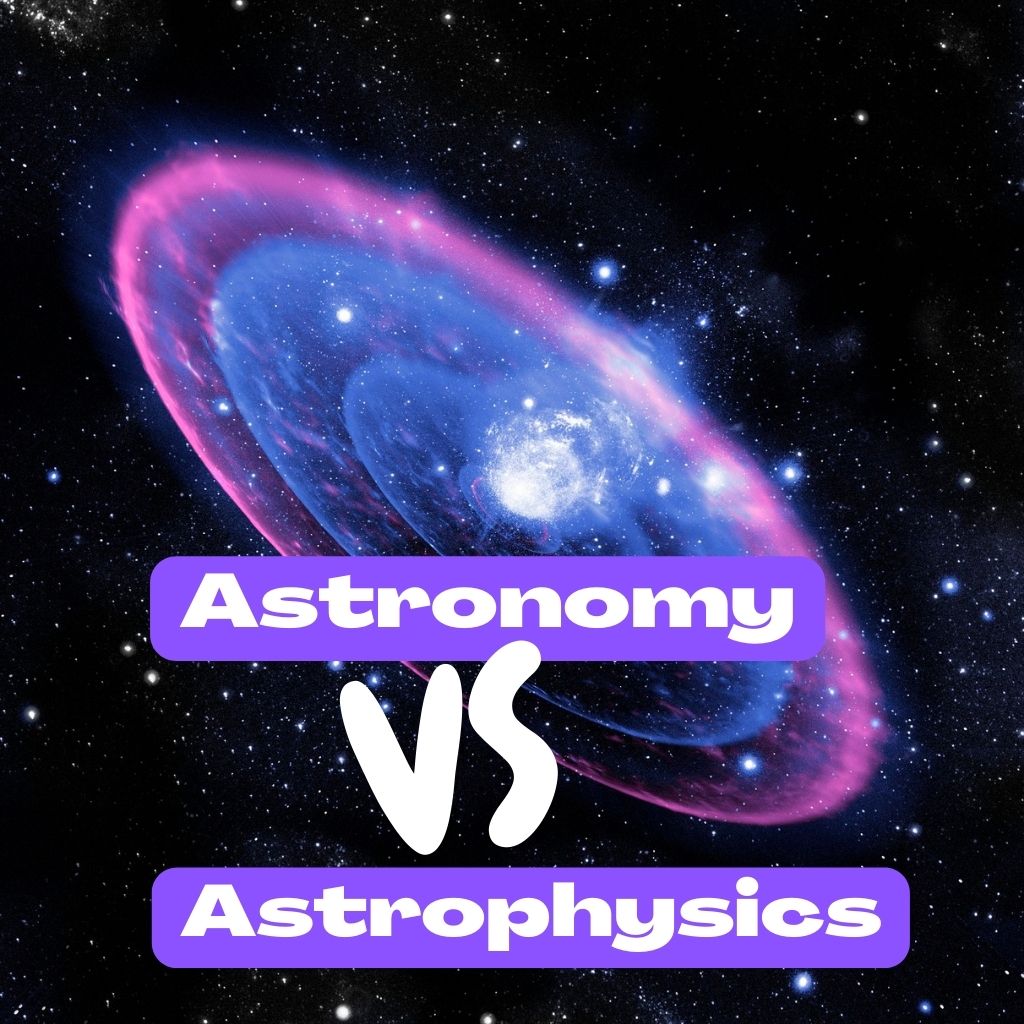This site contains affiliate links to products. I may receive a commission for purchases made through these links.
Astronomy is the branch of science that studies celestial bodies beyond the Earth, while astrophysics is a branch of astronomy that deals with the physical and chemical processes of these bodies and other entities in the universe.
The universe is full of wonders waiting to be discovered. You need to know how astronomy and astrophysics work to uncover these mysteries. However, at a macro level, astronomy and astrophysics might look the same.
If astronomy focuses on what and where of the universe, astrophysics asks how and why.
This article will discuss both fields – astronomy, and astrophysics – in detail, shed light on their key differences, and answer some of the topmost questions about the fields before you embark on your space exploration journey. Let’s begin.
What is astronomy?
We can define astronomy as the study of everything in the universe beyond the Earth. The Moon, the Sun, planets, black holes, stars, faraway galaxies, and other cosmic objects come under astronomy.
Astronomy is the oldest scientific discipline known to humankind. It has been an ancient fascination that started from counting stars and charting constellations with the naked eye and evolved into the sophisticated study we witness today.
It covers many topics that revolve around studying planetary science, cosmology, and searching for extraterrestrial life on other planets.
Astronomers work closely with telescopes to analyze observational data and use it to study the electromagnetic radiation emitted by heavenly objects. They then analyze this data to make sense of the mysteries within the universe.
If you are enthusiastic about astronomy and would like to embark on this journey, some of the best telescopes you can utilize include the Celestron NextStar Evolution telescope, the Celestron NexStar 8SE telescope, and the Sky-Watcher StarTravel 102 AZ3 telescope.
Concepts related to the field of astronomy
Astronomy is a study full of wonders that helps you marvel at the universe and how planets and other objects in the cosmos work in the universe. Let’s look at some of the ideas related to astronomy.
Constellations
The night sky has thousands of stars boiling away in the universe and forming patterns that provoke space enthusiasts to look for answers. These “starry patterns”, known as constellations, may change place but never change shape.
Movement of the Earth and the universe
Imagine the Earth as a spaceship that is carrying you around the universe. Even though you feel like you’re sitting still, the Earth is speeding incredibly fast.
The Earth revolves the run and spins on its axis, while the sun moves around the galaxy’s center and carries everything in the solar system at a rate of 490,000 miles per hour.
And that’s not all. Our galaxy – the Milky Way – moves at 872,405 miles per hour. If you’re wondering what telescope is a good fit for observing these movements, try the Celestron –StarSense Explorer and the Sky-Watcher EvoStar 100 APO.
Types of astronomy
We’ve discussed how astronomy has evolved over the years. The last century split astronomy into two broad categories: observational and theoretical.
Observational astronomy includes telescopes and cameras to collect data about the night sky. On the other hand, theoretical astronomy uses models and theory to understand how objects and phenomena work.
Let’s look at some common astronomy types and discuss them briefly.
- Astrometry: This branch of astronomy includes precise calculations of the sun, the moon, and the planets.
- Astrochemistry: The study of the composition and reactions of ions, molecules, and atoms in space (particle physics).
- Astrobiology: This is an emerging field, but it studies life beyond Earth.
- Stellar astronomy: The study of the structure and life cycle of the star, their classification, and populations of stars.
- Galactic astronomy: The study of how other galaxies (other than the Milky Way) change, form, and die.
What is astrophysics?
Astrophysics studies the universe through the lens of physics. It delves into the physical processes and behaviors of celestial objects with help from some concepts including thermodynamics, relativity, and electromagnetism.
Astrophysics involves using mathematical models and frameworks to study the underlying physics of the universe beyond Earth.
It has two scientific fields that complement its study: cosmology and astronomy. However, these concepts can overlap. Let’s understand how astronomy and astrophysics are connected.
An astronomer would use telescopes, cameras, and other equipment to gather data on a celestial body. An astrophysicist would use that data, along with other tools like photometers and spectrometers, and use laws of physics to understand how that star produces energy, how it moves through space, and whether it has other companion stars.
Observational astrophysics
Observational astrophysics deals with recording and interpreting data and predicting the physical phenomena in the universe.
The information is collected through carriers that make their way to our astronomical instruments on Earth from deep-space, allowing us to observe the universe. These information carriers include electromagnetic radiation and other matter particles such as neutrinos and gravitational waves.
Let’s briefly explore how these information carriers work using advanced telescopes and equipment.
Electromagnetic radiation
Electromagnetic radiation plays a pivotal role in shaping our knowledge of the universe. The production of EM radiation is directly linked to various physical conditions, including the emitter’s nature, motion, temperature, pressure, and magnetic field.
Neutrinos
Neutrinos are elementary particles like electrons in the universe and convey useful information for astrophysicists. However, it carries no electric charge and only interacts via weak interactions. The only telescope currently sensitive enough to detect these high-energy neutrinos is the IceCube Neutrino Observatory.
Gravitational waves
As Albert Einstein’s theory of general relativity predicted, Gravitational waves are tiny spacetime distortions.
They are known to detect astronomical objects like neutron stars and black holes and events like supernovae. These waves also help depict the universe’s processes after the Big Bang.
Nonetheless, you can embark on your space observation journey at a beginner level using some great telescopes, including the Orion 8945 SkyQuest XT8 and the Celestron AstroMaster 114EQ Newtonian telescope.
Theoretical astrophysics
Theoretical astrophysics is different from observational astrophysics and deals with discovering measurable implications of physical models.
If you’re an aspiring astrophysicist, you should get ready to work with various tools like computational numerical simulations and analytical models such as polytropes that help depict star formation and behavior.
Analytical models are there to give insights into the universe and what is going on. On the other hand, numerical methods help you unravel the existence of mind-boggling phenomena and effects in the universe.
Some common topics that fall under the realm of theoretical astrophysics include galaxy formation and evolution, stellar dynamics, the origin of cosmic rays, string cosmology, astroparticle physics, and more.
If you’re familiar with comic inflation, dark energy, dark matter, and the Big Bang in the space industry, know that all these astronomical studies are backed up due to widely accepted and studied theories in astrophysics.
Most of these theories undergo rigorous research in renowned universities.
4 Key differences between astronomy and astrophysics
Astronomy and astrophysics have a common goal but utilize different approaches to achieve that goal. We’ll discuss some key differences to help understand the fine line between the two.
1. Astronomy observes celestial objects, while astrophysics studies their physical properties and processes
Astronomy is more concerned with observing heavenly bodies by using the electromagnetic spectrum. The data collected from these observational techniques transition into astrophysics when physical and chemical knowledge is applied to studying the physical properties and processes of these celestial objects.
2. Astronomy is more observational and descriptive, while astrophysics relies on theoretical models and calculations
Astronomy is still inherently an observational process rather than an experimental science. All the scientific explorations are at a great distance, which only helps to derive descriptions of the universe based on observations. Astrophysics, on the other hand, is more concerned with developing or modifying existing mathematical models and calculations to align with the observations.
3. Astronomy is more concerned with discovering new objects, while astrophysics seeks to explain the behavior of existing bodies
Astronomy helps discover the billions of objects spread in billions of universes. It also deals with determining astronomical distances, measuring the luminosity of a star, and more. But astrophysics focuses on unveiling the phenomena of these heavenly bodies.
4. Astronomy is more accessible to amateur astronomers, while astrophysics requires specialized training and education
Every astrophysicist is an astronomer, but not every astronomer can be an astrophysicist. Astrophysics demands knowledge of the physical laws and in-depth education to describe processes governing the universe.
Astronomy or astrophysics, which is better?
Both astronomy and astrophysics complement each other, but if you’re looking to get into the field, it’s best to start with astronomy. Astronomy deals with observations and encompasses astrophysics as a sub-branch.
Astrophysics is an intensely theoretical subject that depends heavily on advanced mathematics to unravel the mysteries of the universe. So, you should study astronomy if your main interest is non-Earthly physics and you want answers to big astronomical questions like how planets move around.
Astrophysics is for people who want to go beyond the scope of astronomy and study the marvels of the universe in great depth using mathematical models, nuclear physics, quantum mechanics, and more.
Some great telescopes for beginner astronomers include the Gskyer Telescope and the Celestron AstroMaster 70AZ telescope.
You may also like: Telescope vs. Monocular: Which One’s Better for Stargazing?
FAQ – Astronomy vs astrophysics
Here are some frequently asked questions about this field.
Does astrophysics fall under astronomy?
Astrophysics is a branch of astronomy concerned with the physics, evolution, formation, and future of some celestial objects, such as stars, nebulae, and planets. It is a sub-category of astronomy that uses concepts from physics and chemistry to uncover the underlying nature of astronomical objects instead of their relative motions and positions in space.
What are the key differences between astronomy, astrophysics, and cosmology?
Astrophysics is a sub-field of astronomy, while cosmology is a sub-field of astrophysics. Astronomy measures celestial objects’ luminosities, motions, relative positions, and other characteristics. Astrophysics, on the other hand, focuses on generating physical theories and models of small to medium-sized objects and structures in the universe. And lastly, cosmology deals with studying the largest structures in the cosmos and the universe as a whole.
You may also like: What is the Difference Between Astronomy and Astrology
Takeaway: Astronomy and astrophysics are two important fields in the study of the universe
There is so much more than what meets the eye when you deal with the universe. Billions of celestial bodies out there stay undiscovered while scientists, astronomers, astrophysicists, and cosmologists continue to uncover marvelous findings daily.
There is a very thin line between astronomy and astrophysics. But it’s important to discover this thin line to understand these fields.
If you’re intimidated by how astronomy works and want to begin your stargazing journey, check out our detailed article on What is Video Astronomy and Why I Like It?













